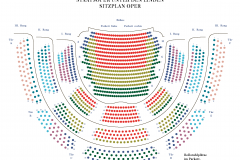The Abduction from the Seraglio
Mo | Tu | We | Th | Fr | Sa | Su |
The Abduction from the Seraglio
Singspiel in three acts (1782)
Music from Wolfgang Amadeus Mozart
Text from Johann Gottlieb Stephanie
Language: Performed in German with German and English surtitles
Recommended Age: Suitable for ages 12 and up
In the summer of 1782, in his twenties, Wolfgang Amadeus Mozart celebrated his greatest opera success yet. With Die Entführung aus dem Serail (The Abduction from the Seraglio), he composed an enormously significant, pioneering work for the Deutsches Nationalsingspiel that had been founded by the Habsburg emperor Joseph II in Vienna, with inspired music and impressively rendered characters.
Mozart brought his wealth of experience with Italian opera to this work, always with an eye for creating a lively, exciting opera experience, combining captivating melodies and vocal brilliance with deeply felt emotions and striking profiles for the characters with their different life worlds. In addition, his distinctive sense for timbre and precisely developed musical processes know how to keep our attention at every moment. Just as the language is translated to music in an amazingly sensitive way, the music takes on an extraordinarily rhetorical power.
Synopsis
Place: the country house of the Pasha (German "Bassa"), in Turkey
Time: 18th century
Act 1
Belmonte enters, looking for his betrothed, Konstanze, who with her English servant Blonde has fallen into the hands of pirates and been sold to Pasha Selim (Aria: "Hier soll ich dich denn sehen" – "Here surely I must find her").[29] Osmin, the Pasha's bad-tempered servant, comes to pluck figs in the garden and completely ignores Belmonte's questions (Aria: "Wer ein Liebchen hat gefunden" – "You may think, you've found a maiden"). Belmonte tries to obtain news of his servant, Pedrillo, who has been captured with the women and is serving as a servant in the Pasha's palace. Osmin replies with insults and abuse (Duet: "Verwünscht seist du samt deinem Liede!" – "The devil take you and your song, sir"). Belmonte leaves in disgust. Pedrillo enters and Osmin rages at him, vowing to get him tortured and killed in many different ways (Aria: "Solche hergelaufne Laffen" – "These young men who go a-spying"). Osmin leaves and Belmonte enters and happily reunites with Pedrillo. Together they resolve to rescue Konstanze and Pedrillo's fiancée, Blonde, who is Konstanze's servant (Aria: "Konstanze, Konstanze, dich wiederzusehen … O wie ängstlich" – "Konstanze, Konstanze, to see thee again … Oh what trembling").
Accompanied by a chorus of Janissaries ("Singt dem großen Bassa Lieder" – "Sing to the mighty Pasha Selim"), Pasha Selim appears with Konstanze, for whose love he strives in vain (Aria of Konstanze: "Ach ich liebte" – "How I loved him"). Pedrillo tricks the Pasha into hiring Belmonte as an architect. When Belmonte and Pedrillo try to enter the palace, Osmin bars their way, but they hurry past him anyway (Terzett: "Marsch! Marsch! Marsch! Trollt euch fort!" – "March! March! March! Clear off!").
Act 2
Blonde repulses the rough lovemaking attempts of Osmin (Aria: "Durch Zärtlichkeit und Schmeicheln" – "With smiles and kind caresses"), and threatens to scratch out his eyes. After a duet ("Ich gehe, doch rate ich dir" – "I'm going, but mark what I say"), Osmin departs. Konstanze greets Blonde in distress (Aria: "Welcher Wechsel herrscht in meiner Seele … Traurigkeit ward mir zum Lose" – "Oh what sorrow overwhelms my spirit … Endless grief tortures my spirit"), informing her that Selim demands her love and threatens to use force (Aria: "Martern aller Arten" – "Tortures unrelenting.")
When she has gone, Pedrillo comes to Blonde, who is his sweetheart, and informs her that Belmonte has come and is planning to rescue them. Blonde is filled with joy. (Aria: "Welche Wonne, welche Lust" – "Oh, the happy, happy day"). Pedrillo invites Osmin to drink, hoping that he will become intoxicated (Aria: "Frisch zum Kampfe" – "Now Pedrillo, now for battle!"; Duet: "Vivat Bacchus! Bacchus lebe!" – "'Here's to Bacchus, long live Bacchus"). When Osmin has drunk himself into a stupor, the two couples reunite (Quartet, Belmonte, Konstanze, Pedrillo, Blonde: "Ach Belmonte! Ach, mein Leben" – "Ah, Belmonte, ah my dear one!"). Belmonte and Pedrillo both question anxiously whether their respective fiancees have remained faithful during their forced separation; to their delight the women respond with indignation and dismay. They forgive the offensive questions and the curtain falls.
Act 3
Belmonte and Pedrillo come to the garden with ladders (Aria, Belmonte: "Ich baue ganz auf deine Stärke" – "Love, only love, can now direct me"; Romanze, Pedrillo: "In Mohrenland gefangen war" – "In Moorish lands a maiden fair"). However, they and the women are caught by Osmin, who rouses the castle (Aria: "Ha, wie will ich triumphieren" – "My triumphant hour's approaching"). Belmonte pleads for their lives and tells Pasha Selim that his father is a Spanish Grandee and Governor of Oran, named Lostados, who will pay a generous ransom. Unfortunately, Pasha Selim and Lostados are long-standing enemies. The Pasha rejoices in the opportunity to kill his enemy's son. He leaves Belmonte and Konstanze to bid each other a last farewell (Duet: "Welch ein Geschick! O Qual der Seele" – "What dreadful fate conspires against us"), but when he returns, he decides he can make a better point against Lostados by releasing Belmonte and his friends. All are set at liberty – much to the dismay of Osmin, who would prefer to see them all brutally executed (Finale: "Nie werd' ich deine Huld verkennen" – "Your noble mercy passes measure").
Program and cast
Musical Director: Thomas Guggeis
Director: Andrea Moses
Set Design: Raimund Bauer
Costumes: Anja Rabes
Chorus Master: Gerhard Polifka
Dramaturgy: Michael Höppner, Detlef Giese
Konstanze: Adela Zaharia
Blonde: Serafina Starke
Belmonte: Siyabonga Maqungo
Pedrillo: Michael Laurenz
Osmin: David Steffens
Bassa Selim: Bülent Ceylan
Staatsopernchor, Staatskapelle Berlin
State Opera Unter den Linden
Staatsoper Unter den Linden is one of Berlin's most prestigious opera houses, with a rich history and significant cultural impact.
History:
The Staatsoper Unter den Linden was originally built between 1741 and 1743, under the direction of architect Georg Wenzeslaus von Knobelsdorff. It was commissioned by Frederick II of Prussia and was initially named the Königliche Oper (Royal Opera). The opera house has undergone several renovations and reconstructions, notably after World War II damage. It reopened in 1984, following a major renovation.
Construction:
The original design was characterized by its Baroque style, featuring an elegant façade and a grand entrance. The building was reconstructed in the 1950s and 1980s, maintaining its classical exterior while modernizing the interior. The façade features a classic portico with six Corinthian columns and a prominent central pediment.
Interior:
The interior is known for its opulent and classical design. The auditorium is renowned for its acoustics and grandeur, with luxurious velvet seats and elaborate decorations. The stage and seating areas have been updated to meet modern performance standards while preserving historical aesthetics.
Concerts and Performances:
The Staatsoper Unter den Linden hosts a variety of performances, including operas, orchestral concerts, and ballet. It is home to the Staatskapelle Berlin, one of Germany's leading orchestras. The opera house is celebrated for its high-quality productions and its role in Berlin’s vibrant cultural scene.
JOURNEY
The Staatsoper Unter den Linden has completely barrier-free access due to its excellent public transport connections.
ADDRESS: Unter den Linden 7; 10117 Berlin
SUBURBAN RAILWAY
S+U Friedrichstraße (S1, S2, S5, S7, S25, S75)
SUBWAY
Hausvogteiplatz (U2)
Museumsinsel (U5)
Stadtmitte (U2, U6)
Unter den Linden (U5, U6)
BUS
Staatsoper (100, 245, 300)
Unter den Linden/Friedrichstraße (100, 147, 245, 300, N6)
PARKING
Q-PARK parking garage Unter den Linden/Staatsoper
Bebelplatz, 10117 Berlin
There are five electric charging stations in the parking garage. Further information can be found here.
The underground car park on Bebelplatz offers disabled parking spaces and direct access to the opera house. On entering the car park between 5.30pm and 11.30pm, the maximum parking fee is €7. To use this tariff, enter your parking ticket in one of the pay machines and the message »Theatertarif« will appear on the display. Please note that it is not possible to use the tariff if you enter the car park before 5.30pm. so it will not be shown on the display. TIP: If you pay the theatre tariff at the pay machine before the event, you can avoid unnecessary waiting after the show.

 EN
EN DE
DE IT
IT FR
FR ES
ES RU
RU JP
JP RO
RO
 Seating plan
Seating plan 